Vitruvius
Marcus Vitruvius Pollio (born c. 80–70 BC, died after c. 15 BC) was a Roman writer, architect and engineer (possibly praefectus fabrum during military service or praefect architectus armamentarius of the apparitor status group), active in the 1st century BC. By his own description[1] Vitruvius served as a Ballista (artilleryman), the third class of arms in the military offices. He likely served as chief of the ballista (senior officer of artillery) in charge of doctores ballistarum (artillery experts) and libratores who actually operated the machines.[2] He has been called the world's first known engineer.[3]
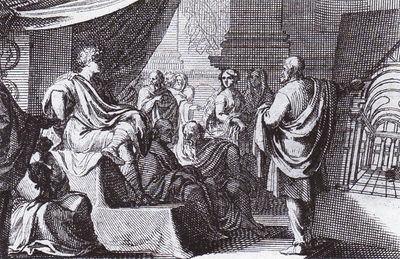
Contents |
Biography
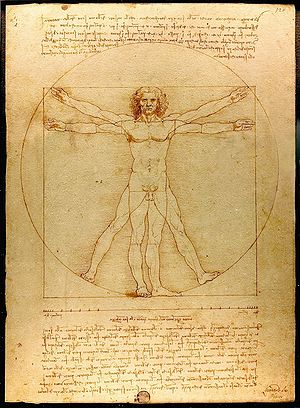
Little is known about Vitruvius' life. His first name Marcus and his cognomen Pollio are uncertain. Cetius Faventinus speaks of "Vitruvius Polio aliique auctores" in his epitome; it is possible that the cognomen derives from this mention by Cetius, meaning Vitruvius, Polio, and others. Most inferences about his life are extracted from his only surviving work De Architectura, though he appears to be known to Pliny the Elder through his description of constructing mosaics[4] in Naturalis Historia, he is not actually named. Frontinus, however, refers to "Vitruvius the architect" in his late 1st century work On Aqueducts (1.25)
Likely born a free Roman citizen, by his own account Vitruvius served the Roman army under Julius Caesar with the otherwise unknown Marcus Aurelius, Publius Minidius, and Gnaeus Cornelius. These names vary depending on the edition of De architectura. Publius Minidius is also written as Publius Numidicus and Publius Numidius, speculated to be the same Publius Numisius inscribed on the Theatre of Heraclea.[5] As an army engineer he specialized in the construction of ballista and scorpio artillery war machines for sieges. It has been speculated that Vitruvius served with Julius Caesar's Chief Engineer Lucius Cornelius Balbus.[6] The locations where he served can be reconstructed from, for example, descriptions of the building methods of various "foreign tribes". Although he describes places throughout De Architectura, he does not say he was present. His service likely included north Africa, Hispania, Gaul (including Aquitaine) and Pontus.
To place the role of Vitruvius the military engineer in context, a description of The Praefect of the camp or army engineer is quoted here as given by Flavius Vegetius Renatus in The Military Institutions of the Romans:
The Praefect of the camp, though inferior in rank to the [Praefect], had a post of no small importance. The position of the camp, the direction of the entrenchments, the inspection of the tents or huts of the soldiers and the baggage were comprehended in his province. His authority extended over the sick, and the physicians who had the care of them; and he regulated the expenses relative thereto. He had the charge of providing carriages, bathorses and the proper tools for sawing and cutting wood, digging trenches, raising parapets, sinking wells and bringing water into the camp. He likewise had the care of furnishing the troops with wood and straw, as well as the rams, onagri, balistae and all the other engines of war under his direction. This post was always conferred on an officer of great skill, experience and long service, and who consequently was capable of instructing others in those branches of the profession in which he had distinguished himself.[7]
At various locations described by Vitruvius, battles and sieges occurred. Of the battlegrounds of the Gallic War there is reference to the siege of Avaricum 52 BC, the Battle of Gergovia 52 BC, the Battle of Alesia 52 BC, and the siege of Uxellodunum 51 BC (all centred on sieges of large Gallic oppida). Of sites involved in Caesar's civil war, we find the Siege of Massilia 49BC,[8] the Battle of Dyrrhachium of 48 BC (Albania), the Battle of Pharsalus 48 BC (Greece), the Battle of Zela of 47 BC (Turkey) and the Battle of Thapsus 46 BC in Caesar's African campaign.[9] A legion that fits the same sequence of locations is the Legio VI Ferrata, of which ballista would be an auxilia unit.
During this same time period a Roman military officer Mamurra also served as praefectus fabrum in Hispania, Gaul and Pontus under Julius Caesar. Some have suggested that these two men may be the same, though there is no mention of Caesar's invasions of Britain in De Architectura, nor of other things with which Mamurra was associated, equestrian military practices and personal wealth. Additionally Caesar appears to have outlived Mamurra, whereas Vitruvius dedicated De Architectura to the emperor Augustus. In later years the emperor Augustus, through his sister Octavia Minor, sponsored Vitruvius, entitling him with what may have been a pension to guarantee financial independence.[1]
Mainly known for his writings, Vitruvius was himself an architect. In Roman times architecture was a broader subject than at present including the modern fields of architecture, construction management, construction engineering, chemical engineering, civil engineering, materials engineering, mechanical engineering, military engineering and urban planning.[10] Frontinus mentions him in connection with the standard sizes of pipes.[11] The only building, however, that we know Vitruvius to have worked on is one he tells us about,[12] a basilica completed in 19 BC.[13] It was built at Fanum Fortunae, now the modern town of Fano. The Basilica di Fano (to give the building its Italian name) has disappeared so completely that its very site is a matter of conjecture, although various attempts have been to visualise it.[14] The early Christian practice of converting Roman basilica (public buildings) into cathedrals implies the basilica may be incorporated into the cathedral located in Fano.
If De architectura was written by one author or is a compilation completed by subsequent librarians and copyists, remains an open question. The date of his death is unknown, which suggests that he had enjoyed only little popularity during his lifetime.
Gerolamo Cardano, in his 16th book De subtilitate rerum, ranks Vitruvius as one of the 12 persons, whom he supposes to have excelled all men in the force of genius and invention; and would not have scrupled to have given him the first place, if it could be imagined that he had delivered nothing but his own discoveries.[15]
De Architectura libri decem (De architectura)
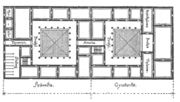
Vitruvius is the author of De architectura, known today as The Ten Books on Architecture,[16] a treatise written of Latin and Greek on architecture, dedicated to the emperor Augustus. In the preface of Book I, Vitruvius dedicates his writings so to give personal knowledge of the quality of buildings to the emperor. Likely Vitruvius is referring to Marcus Agrippa's campaign of public repairs and improvements. This work is the only surviving major book on architecture from classical antiquity. This text "influenced deeply from the Early Renaissance onwards artists, thinkers, and architects, among them Leon Battista Alberti (1404-72), Leonardo Da Vinci (1452-1519), and Michelangelo (1475-1564)."[17] The next major book on architecture, Alberti's reformulation of Ten Books, was not written until 1452.
Vitruvius is famous for asserting in his book De architectura that a structure must exhibit the three qualities of firmitas, utilitas, venustas — that is, it must be solid, useful, beautiful. According to Vitruvius, architecture is an imitation of nature. As birds and bees built their nests, so humans constructed housing from natural materials, that gave them shelter against the elements. When perfecting this art of building, the Ancient Greek invented the architectural orders: Doric, Ionic and Corinthian. It gave them a sense of proportion, culminating in understanding the proportions of the greatest work of art: the human body. This led Vitruvius in defining his Vitruvian Man, as drawn later by Leonardo da Vinci: the human body inscribed in the circle and the square (the fundamental geometric patterns of the cosmic order).
Vitruvius is sometimes loosely referred to as the first architect, but it is more accurate to describe him as the first Roman architect to have written surviving records of his field. He himself cites older but less complete works. He was less an original thinker or creative intellect than a codifier of existing architectural practice. It should also be noted that Vitruvius had a much wider scope than modern architects. Roman architects practised a wide variety of disciplines; in modern terms, they could be described as being engineers, architects, landscape architects, artists, and craftsmen combined. Etymologically the word architect derives from Greek words meaning 'master' and 'builder'. The first of the Ten Books deals with many subjects which now come within the scope of landscape architecture.
Roman technology

Books VIII, IX and X form the basis of much of what we know about Roman technology, now augmented by archaeological studies of extant remains, such as the water mills at Barbegal in France.
Machines
The work is important for its descriptions of the many different machines used for engineering structures such as hoists, cranes and pulleys, as well as war machines such as catapults and ballistae, and siege engines. As a practising engineer, Vitruvius must be speaking from personal experience rather than simply describing the works of others. He also describes the construction of sundials and water clocks, and the use of an aeolipile (the first steam engine) as an experiment to demonstrate the nature of atmospheric air movements (wind).
Aqueducts
His description of aqueduct construction includes the way they are surveyed, and the careful choice of materials needed, although Frontinus writing a century later gives much more detail of the practical problems involved in their construction and maintenance. Vitruvius was writing in the first century BC when many of the finest Roman aqueducts were built, and survive to this day, such as those at Segovia and the Pont du Gard. The use of the inverted siphon is described in detail, together with the problems of high pressures developed in the pipe at the base of the siphon, a practical problem with which he seems to be acquainted. His book would have been of great assistance to Frontinus, a general who was appointed in the late first century AD to administer the many aqueducts of Rome. He discovered a discrepancy between the intake and supply of water caused by illegal pipes inserted into the channels to divert the water.
Materials
He describes many different construction materials used for a wide variety of different structures, as well as such details as stucco painting. Concrete and lime receive in-depth descriptions, the longevity of many Roman structures being mute testimony to the Romans' skill in building materials and design.
Vitruvius is well known and often cited as one of the earliest surviving sources to have advised that lead should not be used to conduct drinking water, recommending clay pipes or masonry channels. He comes to this conclusion in Book VIII of De Architectura after empirical observation of the apparent laborer illnesses in the lead foundries of his time. [18]
Vitruvius gives us the famous story about Archimedes and his detection of adulterated gold in a royal crown. When Archimedes realised that the volume of the crown could be measured exactly by the displacement created in a bath of water, he ran into the street with the cry of Eureka!, and the discovery enabled him to compare the density of the crown with pure gold. He showed that the crown had been alloyed with silver, and the king defrauded.
Dewatering machines

He describes the construction of Archimedes' screw in Chapter X, although doesn't mention Archimedes by name. It was a device widely used for raising water to irrigate fields and dewater mines. Other lifting machines he mentions include the endless chain of buckets and the reverse overshot water-wheel, a spectacular example of a sequence of such wheels being shown above. Remains of the water wheels used for lifting water have been discovered in old mines such as those at Rio Tinto in Spain and Dolaucothi in west Wales. The former now is shown in the British Museum, and the latter in the National Museum of Wales. The remains were discovered when these mines were re-opened in modern mining attempts.
Surveying instruments
That he must have been well practised in surveying is shown by his descriptions of surveying instruments, especially the water level or chorobates, which he compares favourably with the groma, a device using plumb lines. They were essential in all building operations, but especially in aqueduct construction, where a uniform gradient was important to provision of a regular supply of water without damage to the walls of the channel. He also developed one of the first odometers, consisting of a wheel of known circumference that dropped a pebble into a container on every rotation.
Central heating
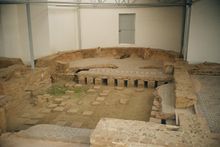
He describes the many innovations made in building design to improve the living conditions of the inhabitants. Foremost among them is the development of the hypocaust, a type of central heating where hot air developed by a fire was channelled under the floor and inside the walls of public baths and villas. He gives explicit instructions how to design such buildings so that fuel efficiency is maximised, so that for example, the caldarium is next to the tepidarium followed by the frigidarium. He also advises on using a type of regulator to control the heat in the hot rooms, a bronze disc set into the roof under a circular aperture which could be raised or lowered by a pulley to adjust the ventilation. Although he does not suggest it himself, it is likely that his dewatering devices such as the reverse overshot water-wheel was used in the larger baths to lift water to header tanks at the top of the larger thermae, such as the Baths of Diocletian and the Baths of Caracalla.
Rediscovery
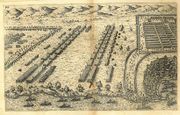
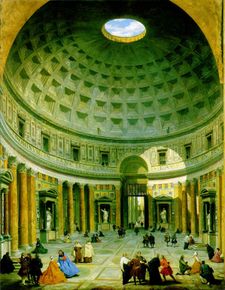
His book De architectura was rediscovered in 1414 by the Florentine humanist Poggio Bracciolini. To Leon Battista Alberti (1404-1472) falls the honour of making this work widely known in his seminal treatise on architecture De re aedificatoria (ca. 1450). The first known edition of Vitruvius was in Rome by Fra Giovanni Sulpitius in 1486. Translations followed in Italian (Como, 1521), French (Jean Martin, 1547,[19] English, German (Walter H. Ryff, 1543) and Spanish and several other languages. The original illustrations had been lost and the first illustrated edition was published in Venice in 1511 with woodcut illustrations, based on descriptions in the text, probably by Fra Giovanni Giocondo.[20] Later in the sixteenth-century Andrea Palladio provided illustrations for Daniele Barbaro's commentary on Vitruvius (which appeared in Italian and Latin versions). However, the most famous illustration remains a fifteenth-century one, Da Vinci's Vitruvian Man.
The surviving ruins of Roman antiquity, the Roman Forum, temples, theatres, triumphal arches and their reliefs and statues gave ample visual examples of the descriptions in the Vitruvian text. This book then quickly became a major inspiration for Renaissance, Baroque and Neoclassical architecture. Brunelleschi, for example, invented a new type of hoist to lift the large stones for the dome of the cathedral in Florence and was prompted by De Architectura as well as viewing the many surviving Roman monuments like the Pantheon and the Baths of Diocletian in Rome.
Lists of names given in Book VII Introduction
In book seven's introduction Vitruvius goes through great lengths to present his credentials for writing De Architectura. Similar in concept to a modern day reference section, the author's position as one who is knowledgeable and educated is established. The topics listed range across many fields of expertise reflecting that in Roman times as today construction is a diverse field. It is apparent that many ancient lost works and their authors are known only because they are referred to by other authors whose works have survived. Vitruvius makes the further point that the work of some of the most talented is unknown, while many who are of lesser talent but greater political position are famous. This theme runs through Vitruvius’s ten books repeatedly and here in the introduction to Chapter 7, he illustrates this by naming (in addition to some very well known names), some of the most talented individuals in history:
- List of physicists Thales, Democritus, Anaxagoras, Xenophanes
- List of philosophers Socrates, Plato, Aristotle, Zeno, Epicurus
- List of kings Croesus, Alexander the Great, Darius
- On plagiarism Aristophanes, Ptolemy I Soter, Attalus
- On abusing dead authors Zoilus Homeromastix, Ptolemy II Philadelphus
- On divergence of the visual rays Agatharchus, Aeschylus, Democritus, Anaxagoras
- List of writers on temples Silenus, Theodorus, Chersiphron and Metagenes, Ictinus and Carpion, Theodorus the Phocian, Hermogenes, Arcesius, Satyrus and Pytheos
- List of Artists Leochares, Bryaxis, Scopas, Praxiteles, Timotheus (Timotheos)
- List of writers on laws of symmetry Nexaris, Theocydes, Demophilus, Pollis, Leonidas, Silanion, Melampus, Sarnacus, Euphranor
- List of writers on machinery Diades of Pella, Archytas, Archimedes, Ctesibius, Nymphodorus, Philo of Byzantium, Diphilus, Democles, Charias, Polyidus of Thessaly, Pyrrus, Agesistratus, Abdaraxus
- List of writers on architecture Fuficius, Terentius Varro, Publius Septimius (writer)
- List of architects Antistates, Callaeschrus, Antimachides, Pormus, Cossutius
- List of greatest temple architects Chersiphron of Gnosus, Metagenes, Demetrius, Paeonius the Milesian, Ephesian Daphnis, Ictinus, (Philo) Philon, Cossutius, Gaius Mucius
Legacy
- A small lunar crater has been named after Vitruvius and also an elongated lunar mountain Mons Vitruvius close-by. This crater was near the valley that served as the landing site of the Apollo 17 mission.
- The Design Quality Indicator (DQI) tool for the measurement of the design quality of buildings uses Vitruvius's principles.
See also
- Archimedes
- Aristotle
- Ctesibius
- Colen Campbell
- Frontinus
- Pliny the Elder
- Roman architecture
- Roman aqueducts
- Roman engineering
- Roman technology
- Vitruvian man
- Vitruvian scroll
References
- ↑ 1.0 1.1 De Arch. Book 1, preface. section 2
- ↑ Yann Le Bohec "The Imperial Roman Army" Routledge, pg 49 2000 ISBN 0-415-22295-8 [1]
- ↑ The art of bridging the gap - The New Zealand Herald, Saturday 30 May 2009
- ↑ Moore, Richard E. M. (January 1968). A Newly Observed Stratum in Roman Floor Mosaics. 72. Archaeological Institute of America. pp. 57–68. http://www.jstor.org/stable/501823. Retrieved 2009-11-14.
- ↑ Niccolò Marcello Venuti “Description of the First Discoveries of the Ancient City Of Heraclea, Found Near Portici A Country Palace Belonging To The King Of The Two Sicilies” published by R. Baldwin, translated by Wickes Skurray, 1750. p62 [2]
- ↑ Trumbull, David (2007). "Classical Sources, Greek and Roman Esthetics Reading: The Grand Tour Reader; Vitruvius Background: Life of Marcus Vitruvius Pollio (c. 90-20 B.C.E.)". An Epitome of Book III of Vitruvius. http://medieval.ucdavis.edu/GRAND.TOUR/Lecture02.html. Retrieved 11/18/2009.
- ↑ Flavius Vegetius Renatus "The Military Institutions of the Romans" Translated from the Latin by Lieutenant John Clarke, Text written in 390 A.D. British translation published in 1767. Copyright Expired, http://www.pvv.ntnu.no/~madsb/home/war/vegetius/
- ↑ Vitruvius mentions Massilia several times, and the siege itself in Book X.
- ↑ "Vitruvius" from Pegasos website accessed August 2008
- ↑ The "Vitruvius Project" at Carnegie Mellon University, Computer Science Department This software engineering project sees itself in the Vitruvian tradition. Accessed August 2008
- ↑ De Aquis, I.25 (Latin) ebook of work also known as De aquaeductu, accessed August 2008
- ↑ (De Arch., Book V.i.6) (Latin) but with link to English translation, accessed August 2008
- ↑ Fausto Pugnaloni and Paolo Clini "Vitruvius Basilica in Fano, Italy, journey through the virtual space of the reconstructed memory" GISdevelopment.net last accessed 3/8/2008[3]
- ↑ P. Clini "VITRUVIUS’ BASILICA AT FANO: THE DRAWINGS OF A LOST BUILDING FROM DE ARCHITECTURA LIBRI DECEM" The International Archives of the Photogrammetry, Remote Sensing and Spatial Information Sciences, Vol. XXXIV, Part 5/W12 pp121 - 126 2002 [4]
- ↑ Hutton, Charles Mathematical and Philosophical Dictionary 1795
- ↑ Vitruvius, Pollio (transl. Morris Hicky Morgan, 1960), The Ten Books on Architecture. Courier Dover Publications. ISBN 0-486-20645-9.
- ↑ Liukkonen, Petri (2008), Vitruvius (fl. 46-30 B.C.), http://www.kirjasto.sci.fi/vitruv.htm, retrieved November 14, 2009
- ↑ Hodge, Trevor, A. (October 1981). Vitruvius, Lead Pipes and Lead Poisoning. 85. Archaeological Institute of America. pp. 486–491. http://www.jstor.org/stable/504874. Retrieved 2009-11-14.
- ↑ Architectura - Les livres d'Architecture (French)
- ↑ Architectura - Les livres d'Architecture; Center for Palladian Studies in America, Inc., Palladio's Literary Predecessors
- Indra Kagis McEwen, Vitruvius: Writing the Body of Architecture. Cambridge, MA: MIT Press, 2004. ISBN O-262-63306-X
- B. Baldwin, "The Date, Identity, and Career of Vitruvius." In Latomus 49 (1990), 425-34.
External links
- The Ten Books on Architecture online: cross-linked Latin text and English translation
- The Ten Books on Architecture at the Perseus Classics Collection. Latin and English text. Images. Latin text has hyperlinks to pop-up dictionary.
- Palladio's Literary Predecessors
- Latin text, version 2
- An Abridgment of the Architecture of Vitruvius
- Ten Books on Architecture at Project Gutenberg (Morris Hicky Morgan translation with illustrations)
- Vitruvius on line: *http://architectura.cesr.univ-tours.fr/Traite/Auteur/Vitruve.asp?param=
- Leonardo da Vincis Vitruvian man as an algorithm for the approximation of the squaring of the circle
- Vitruvius' theories of beauty - a learning resource from the British Library
- Shockwave-Animation: The Odometer of Vitruv
- Discussion of the inventions of Vitruvius
 "Diocese of Fano". Catholic Encyclopedia. New York: Robert Appleton Company. 1913.
"Diocese of Fano". Catholic Encyclopedia. New York: Robert Appleton Company. 1913.- Spanish site dedicated to Roman technology, especially aqueducts and mines
|
|||||||||||||||||||||||||||||||||||||||||||||||||||||||||